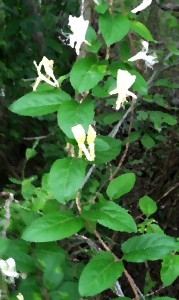One man’s cliche is another man’s philosophy. Whoa! Maybe that’s two, SMACK, two, SMACK, two cliches in one. Whatever. Maybe that’s a little too heavy for me when all I want to say is I stopped to smell the roses today except the roses weren’t roses but were instead honeysuckle vines.
It’s hard to smell the honeysuckle on a warm, windy, humid day here in Beaumont, Southeast Texas, USA. Especially such is the case since the wind is coming from the direction of most of the petrochemical plants in the area. As I have noted here before, the plants don’t smell as bad as they used to back in the latter part of the 20th century. But odors do become more acute on very humid days. I’m sure there is a scientific reason for that, or maybe it is just baloney. I just know I smelled more chemical plant or refinery on the short walk I took this afternoon to the extent I had to get close up to smell the honeysuckle.

There are three sensory experiences that remind me of my roots in the Pineywoods of East Texas. One is the sound of the wind as it wafts through the trees in a pine forest. Number two is the haunting sound of the lonesome whip-poor-will. Perhaps it is always described as lonesome because it is poor, whipped and has no will? Who knows. And third is the sweet smell of the honeysuckle vine. Well, I suppose I could add a forth: The sound of the morning sawmill whistle blowing. I don’t know if such a noise exists anymore. At least, I doubt it exists anywhere in East Texas to the extent that the whole town can hear it as when I was a child.
A reference to honeysuckle is not to a single vine or vine flower. But I really don’t know the difference between all the different types including the invasive Japanese honeysuckle. Where I grew up a certain type of honeysuckle was actually known as a wild azaleas. An area was set aside by a timber company on which a trail exists for both birding and for checking out the namesake wild azaleas. It is named, appropriately, the Wild Azalea Canyons Trail. The wild azaleas peak blooming is supposedly late March but they may still be blooming well. This is certainly no Grand Canyon but it is a decent walk down and back up.
It doesn’t take a road trip or a vacation, however, to enjoy what’s out there. Often all one has to do is step outside. Sometimes you will see something for the first time that may have been there all along. That is when you know you need to stop to smell the honeysuckle a little more often.

Spelling error report
The following text will be sent to our editors: